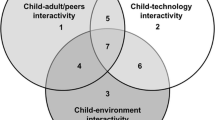Abstract
This paper addresses the integrated use of the arts and digital technology in mathematics education—specifically involving aspects of preservice teachers’ mathematical activity while engaging in music production, in pedagogic scenarios conceived of as aesthetic mathematical experiences (AMEs). Theoretically, the research evokes notions such as digital mathematical performance, aesthetics, humans-with-media, and musical theory. Methodologically, the study presents a pedagogic model for mathematics teaching and learning through music production; the model is elaborated using qualitative case studies in which preservice teachers (education majors and mathematics majors) created mathematical songs with music software. In their songs, the education majors explored place value and the mathematics majors explored progressions. The research highlights the mathematical ideas and the narrative nature of the lyrics, as well as the digital structure of the songs created collectively. The study also emphasizes aspects of thinking-with-music-software related to musical concepts such as intervals, note values, and harmonic fields. The results reveal that the AMEs offered ways for preservice teachers to think mathematically and aesthetically through the composition of the lyrics and by the creation of virtual instruments with music software.











Similar content being viewed by others
Notes
In Brazil, place value manipulatives are called “Golden Material”.
G# (fifth), F# (fourth), E (third), C# (tonic).
References
Abdounur, O. J. (2003). Mathematics and music: Analogic thinking in meaning construction. Sao Paulo: Escrituras Editora.
An, S. A., Ma, T., & Capraro, M. M. (2011). Preservice teachers’ beliefs and attitude about teaching and learning mathematics through music: An intervention study. School Science and Mathematics Journal, 111, 236–248.
An, S. A., Tillman, D., Shaheen, A., & Boren, R. (2014). Preservice teachers’ perception about teaching mathematics through music. Journal of Interdisciplinary Teaching and Learning, 4(3), 150–171.
Bicudo, M. A. V. (1993). Research in mathematics education. Pro-posições, 4(10), 18–23.
Boal, A. (2006). The aesthetics of the oppressed. New York: Routledge.
Borba, M. C., & Gadanidis, G. (2008). Virtual communities and networks of practising mathematics. In K. Krainer & T. Wood (Eds.), The international handbook of mathematics teachers education. Participants in mathematics teacher education. Individual, teams, communities and networks (Vol. 3, pp. 181–206). Rotterdam/Taipei: Sense Publishers.
Borba, M. C., Scucuglia, R. R. S., & Gadanidis, G. (2014). Phases of digital technologies in mathematics education: The classroom and the internet in motion (1st ed.). Belo Horizonte: Autêntica.
Borba, M. C., & Villarreal, M. (2005). Humans-with-media and reorganization of mathematical thinking: Information and communication technologies, modeling, experimentation and visualization. Berlin: Springer.
Courey, S. J., Balogh, E., Siker, J. R., & Paik, J. (2012). Academic music: Music instruction to engage third-grade students in learning basic fraction concepts. Educational Studies in Mathematics, 81(2), 251–278.
Dewey, J. (2010). Art as experience. Sao Paulo, Brazil: Martins Fontes.
Doxiadis, A. (2003). Embedding mathematics in the soul: Narrative as a force in mathematics education. In Opening address to the Third Mediterranean Conference of Mathematics Education, Athens, Greece.
Gadanidis, G., & Borba, M. C. (2006). Digital mathematical performance. https://www.edu.uwo.ca/dmp/.
Gadanidis, G., & Borba, M. (2008). Our lives as performance mathematicians. For the Learning of Mathematics, 28(1), 44–51.
Gadanidis, G., Borba, M., Hughes, J., & Lacerda, H. (2016). Designing aesthetic experiences for young mathematicians: A model for mathematics education reform. International Journal of Research in Mathematics Education, 6(2), 225–244.
Gadanidis, G., & Geiger, V. (2009). A social perspective on technology-enhanced mathematical learning: From collaboration to performance. ZDM Mathematics Education, 42(1), 91–104.
Gadanidis, G., Hughes, J., & Borba, M. (2008). Students as performance mathematicians. Mathematics Teaching in the Middle School, 14(3), 168–175.
Gadanidis, G., & Scucuglia, R. (2010). Windows into elementary mathematics: Alternate public images of mathematics and mathematicians. Acta Scientiae, 12(1), 8–23.
Gerstberger, H. (2009). Mathematics learning and aesthetic production. ZDM Mathematics Education, 41(1–2), 61–73.
Gregorutti, G. S. (2016). Digital mathematical performance and public image of mathematics: poetical enterprise in preservice teacher education. Masters’ thesis (in mathematics education). Rio Claro: Sao Paulo State University.
Houdement, C., & Tempier, F. (2019). Understanding place value with numeration units. ZDM Mathematics Education, 51(1), 25–37.
Howe, R. (2018). Learning and using our base ten place value number system: Theoretical perspectives and twenty-first century uses. ZDM Mathematics Education, 51(1), 57–68.
Leviatan, Y. (2017). Making music: The 6 stages of music production. https://www.waves.com/six-stages-of-music-production. Accessed 11 Mar 2019.
Levy, P. (2001). Cyberculture. Minneapoliss: University of Minnesota Press.
Marshall, M. N. (1996). Sampling for qualitative research. Family Practice, 13(6), 522–526.
Martínez-Planell, R., Gonzalez, A., DiCristina, G., & Acevedo, V. (2012). Students’ conception of infinite series. Educational Studies in Mathematics, 81, 235–249.
Pilhofer, M., & Day, H. (2007). Music theory for dummies. New York: Wiley Publishing Inc.
Powell, A., Francisco, J., & Maher, C. (2003). An analytical model for studying the development of learners’ mathematical ideas and reasoning using videotape data. The Journal of Mathematical Behavior, 22(4), 405–435.
Rory, P. Q. (2018, October 24). Basic music theory for beginners—the complete guide. Retrieved from https://iconcollective.com/basic-music-theory/. Accessed 10 July 2019.
Sao, Paulo. (2011). Curriculum of Sao Paulo State: Mathematics and its technologies. Sao Paulo: Ministry of education of State of Sao Paulo.
Sao, Paulo. (2014). Mathematics curriculum: Elementary school Grades 1-5. Sao Paulo: Ministry of education of State of Sao Paulo.
Scucuglia, R. (2012). On the nature of students’ digital mathematical performances. Doctoral dissertation. London: The University of Western Ontario
Scucuglia, R. (2014). Multimodal narratives: The image of mathematicians in digital mathematical performances. Bolema, 28(49), 950–973.
Sinclair, N. (2009). Aesthetics as a liberating force in mathematics education? ZDM Mathematics Education, 41(1), 45–60.
Stake, R. E. (2000). Case studies. In N. K. Denzin & Y. S. Lincoln (Eds.), Handbook of qualitative research (pp. 435–453). Thousand Oaks: Sage.
Wright, D. (2009). Mathematics and music. Providence: American Mathematical Society.
Acknowledgements
CNPq—Brazilian Council for Scientific and Technological Development (428323/2018/-9).
Author information
Authors and Affiliations
Corresponding author
Additional information
Publisher's Note
Springer Nature remains neutral with regard to jurisdictional claims in published maps and institutional affiliations.
Rights and permissions
About this article
Cite this article
da Silva, R.S.R. On music production in mathematics teacher education as an aesthetic experience. ZDM Mathematics Education 52, 973–987 (2020). https://doi.org/10.1007/s11858-019-01107-y
Accepted:
Published:
Issue Date:
DOI: https://doi.org/10.1007/s11858-019-01107-y



